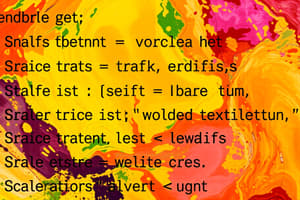Podcast
Questions and Answers
Which of the following best describes a Swift String?
Which of the following best describes a Swift String?
- An immutable sequence of characters, similar to C-style strings.
- A mutable sequence of characters that can only represent ASCII characters.
- A fast, Unicode-compliant value type representing a sequence of characters. (correct)
- A reference type representing a sequence of bytes.
String interpolation allows you to insert only constants and variables into a string literal.
String interpolation allows you to insert only constants and variables into a string literal.
False (B)
How do you create a multiline string literal in Swift?
How do you create a multiline string literal in Swift?
By surrounding the string with three double quotation marks (""").
In Swift, to prevent a line break from being included in a multiline string literal, you can use a ______ at the end of the line.
In Swift, to prevent a line break from being included in a multiline string literal, you can use a ______ at the end of the line.
Match the following escape sequences with their corresponding special characters:
Match the following escape sequences with their corresponding special characters:
What is the purpose of extended string delimiters in Swift?
What is the purpose of extended string delimiters in Swift?
An empty string in Swift can only be created using an empty string literal ("").
An empty string in Swift can only be created using an empty string literal ("").
How do you check if a String value is empty in Swift?
How do you check if a String value is empty in Swift?
In Swift, String is a ______ type, meaning that when a String value is passed to a function, a copy of the string is created.
In Swift, String is a ______ type, meaning that when a String value is passed to a function, a copy of the string is created.
Which of the following methods is used to append a Character to a String?
Which of the following methods is used to append a Character to a String?
You can directly access a Character in a Swift String using an integer index like an array.
You can directly access a Character in a Swift String using an integer index like an array.
What is the startIndex property of a String used for?
What is the startIndex property of a String used for?
The endIndex property of a String represents the position ______ the last character in a String.
The endIndex property of a String represents the position ______ the last character in a String.
Which method is used to insert a string into another string at a specific index?
Which method is used to insert a string into another string at a specific index?
The remove(at:) method removes a substring from a string given a range.
The remove(at:) method removes a substring from a string given a range.
What is a Unicode scalar value?
What is a Unicode scalar value?
A sequence of one or more Unicode scalars that produce a single human-readable character is called an ______ grapheme cluster.
A sequence of one or more Unicode scalars that produce a single human-readable character is called an ______ grapheme cluster.
How do you retrieve the number of Character values in a String?
How do you retrieve the number of Character values in a String?
String concatenation always affects the string's character count.
String concatenation always affects the string's character count.
Which of the following demonstrates correct string interpolation to display the result of multiplying x and y?
Which of the following demonstrates correct string interpolation to display the result of multiplying x and y?
Flashcards
String
String
A series of characters, represented by the String type in Swift.
String Literal
String Literal
A sequence of characters surrounded by double quotation marks ("). Used as an initial value for a constant or variable.
Multiline String Literal
Multiline String Literal
A sequence of characters surrounded by three double quotation marks. Includes all lines between the opening and closing quotation marks and preserves line breaks.
Special Characters in Strings
Special Characters in Strings
Signup and view all the flashcards
Extended String Delimiters
Extended String Delimiters
Signup and view all the flashcards
Initializing an Empty String
Initializing an Empty String
Signup and view all the flashcards
String Mutability
String Mutability
Signup and view all the flashcards
Strings Are Value Types
Strings Are Value Types
Signup and view all the flashcards
Working with Characters
Working with Characters
Signup and view all the flashcards
Concatenating Strings
Concatenating Strings
Signup and view all the flashcards
String Interpolation
String Interpolation
Signup and view all the flashcards
Unicode
Unicode
Signup and view all the flashcards
Unicode Scalar Values
Unicode Scalar Values
Signup and view all the flashcards
Extended Grapheme Clusters
Extended Grapheme Clusters
Signup and view all the flashcards
Counting Characters
Counting Characters
Signup and view all the flashcards
String Indices
String Indices
Signup and view all the flashcards
Inserting into a String
Inserting into a String
Signup and view all the flashcards
Study Notes
- A string is a series of characters
- Swift strings are represented by the
Stringtype - Contents of a
Stringcan be accessed as a collection ofCharactervalues - Swift's
StringandCharactertypes are Unicode-compliant - Syntax for string creation and manipulation is readable, similar to C
- String concatenation combines two strings with the
+operator - String mutability is managed by choosing between a constant or a variable
- Strings can insert constants, variables, literals, and expressions via string interpolation
- Swift's
Stringtype is a fast, modern string implementation composed of Unicode characters
String Literals
- Predefined
Stringvalues can be included within code as string literals - String literals are a sequence of characters surrounded by double quotation marks (
") - You can use a string literal as an initial value for a constant or variable
- Swift infers a type of
Stringfor constants initialized with a string literal value
Multiline String Literals
- For strings spanning several lines, use multiline string literals, which are surrounded by three double quotation marks (
""") - Multiline string literals include all lines between the opening and closing quotation marks
- The string begins on the first line after the opening quotation marks (
""") and ends on the line before the closing quotation marks - Line breaks inside a multiline string literal appear in the string's value
- Use a backslash (
\) at the end of a line to prevent line breaks from being part of the string's value - To start or end a multiline string literal with a line feed, use a blank line as the first or last line
- Multiline strings can be indented to match surrounding code
- Whitespace before the closing quotation marks determines which whitespace is ignored before other lines
- Extra whitespace at the beginning of a line beyond the indentation of the closing quotes is included
Special Characters in String Literals
- String literals can include special characters:
- Escaped special characters:
\0(null),\\(backslash),\t(horizontal tab),\n(line feed),\r(carriage return),\"(double quote),\'(single quote) - Unicode scalar values:
\u{n}, where n is a 1–8 digit hexadecimal number
- Escaped special characters:
- Double quotation marks (
") can be included inside a multiline string literal without escaping - To include the text
"""in a multiline string, escape at least one of the quotation marks
Extended String Delimiters
- String literals can be placed within extended delimiters (quotation marks and number signs
#) to include special characters without invoking their effect - Printing
#"Line 1\nLine 2"#prints the line feed escape sequence (\n) rather than printing the string across two lines - The number of number signs within the string following the escape character (
\) should match the number of number signs surrounding the string - String literals created using extended delimiters can also be multiline string literals
- Extended delimiters can include the text
"""in a multiline string, overriding the default behavior
Initializing an Empty String
- Create an empty
Stringby assigning an empty string literal to a variable or initializing a newStringinstance-
var emptyString = "" var anotherEmptyString = String()
-
- Check if a
Stringvalue is empty using its BooleanisEmptyproperty
String Mutability
- Assign a
Stringto a variable to allow modification - Assign a
Stringto a constant to prevent modification
Strings Are Value Types
- Swift's
Stringtype is a value type - When a
Stringis passed to a function/method or assigned to a constant/variable, it is copied - Swift's compiler optimizes string usage so that actual copying takes place only when absolutely necessary.
Working with Characters
- Access individual
Charactervalues of aStringby iterating with afor-inloop - Create a stand-alone
Characterconstant or variable from a single-character string literal by providing aCharactertype annotation - Construct
Stringvalues by passing an array ofCharactervalues as an argument to its initializer
Concatenating Strings and Characters
- Use the addition operator (
+) to concatenateStringvalues and create a newStringvalue - Append a
Stringvalue to an existingStringvariable with the addition assignment operator (+=) - Append a
Charactervalue to aStringvariable using theStringtype’sappend()method - Ensure every line ends with a line break when building up longer strings with multiline string literals
String Interpolation
- String interpolation constructs a new
Stringvalue from a mix of constants, variables, literals, and expressions - Insert items into a string literal by wrapping them in parentheses, prefixed by a backslash (
\) - Use extended string delimiters to create strings containing characters that would otherwise be treated as a string interpolation
- To use string interpolation inside a string that uses extended delimiters, match the number of number signs after the backslash to the number of number signs surrounding the string.
Unicode
- Unicode is an international standard for encoding, representing, and processing text
- Swift’s
StringandCharactertypes are fully Unicode-compliant
Unicode Scalar Values
- Swift’s native
Stringtype is built from Unicode scalar values - A Unicode scalar value is a unique 21-bit number for a character or modifier
Extended Grapheme Clusters
- Swift's
Charactertype represents a single extended grapheme cluster - An extended grapheme cluster is a sequence of one or more Unicode scalars that produce a single human-readable character
Counting Characters
- Use the
countproperty to retrieve a count ofCharactervalues in a string - String concatenation and modification may not always affect string character count
- Appending a combining acute accent to "cafe" results in "café", but the character count remains 4
Accessing and Modifying a String
String Indices
- Each
Stringvalue has an associated index type,String.Index, corresponding to the position of eachCharacter - Swift strings cannot be indexed by integer values due to variable memory allocation for different characters
startIndexproperty accesses the position of the firstCharacterof aStringendIndexproperty is the position after the last character in aStringendIndexproperty isn’t a valid argument to a string’s subscriptstartIndexandendIndexare equal when aStringis empty- Access indices before and after a given index using the
index(before:)andindex(after:)methods ofString - Use the
index(_:offsetBy:)method to access an index farther away from the given index, instead of callingindex(before:)andindex(after:)multiple times. - Use subscript syntax to access the
Characterat a particularStringindex - Accessing an index outside of a string’s range or a
Characterat an index outside of a string’s range will trigger a runtime error - Use
indicesproperty to access all of the indices of individual characters in a string
Inserting and Removing
- Use the
insert(_:at:)method to insert a single character at a specified index in a string - Use the
insert(contentsOf:at:)method to insert the contents of another string at a specified index - Use the
remove(at:)method to remove a single character at a specified index in a string - Use the
removeSubrange(_:)method to remove a substring at a specified range
Studying That Suits You
Use AI to generate personalized quizzes and flashcards to suit your learning preferences.




